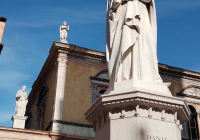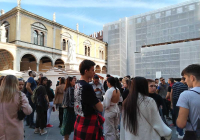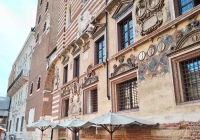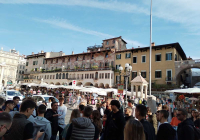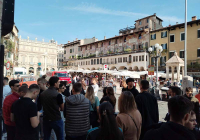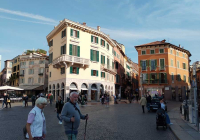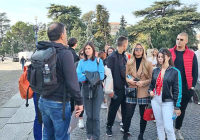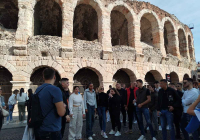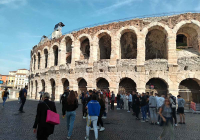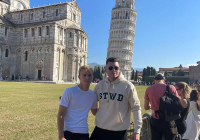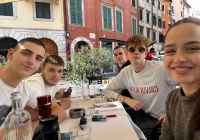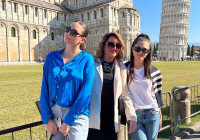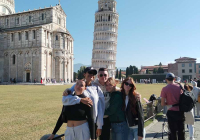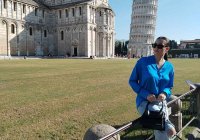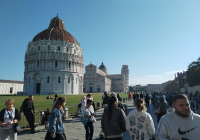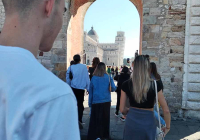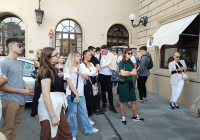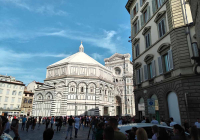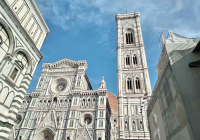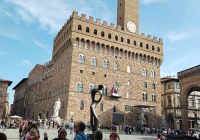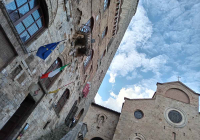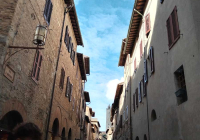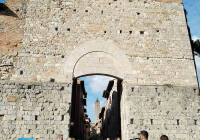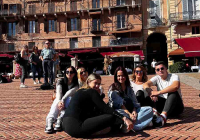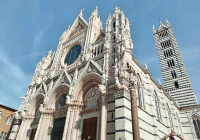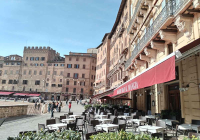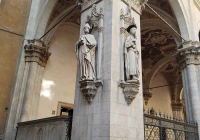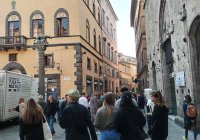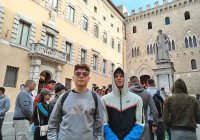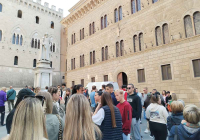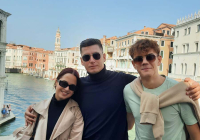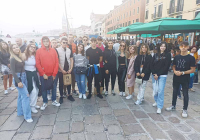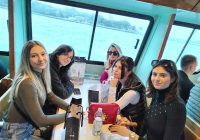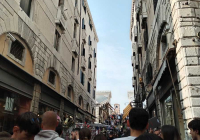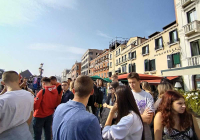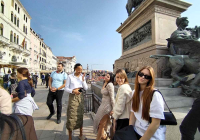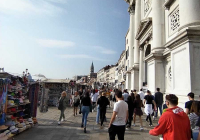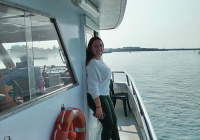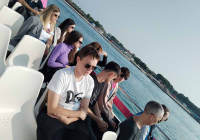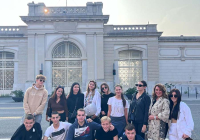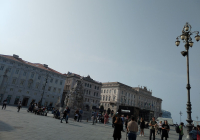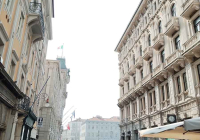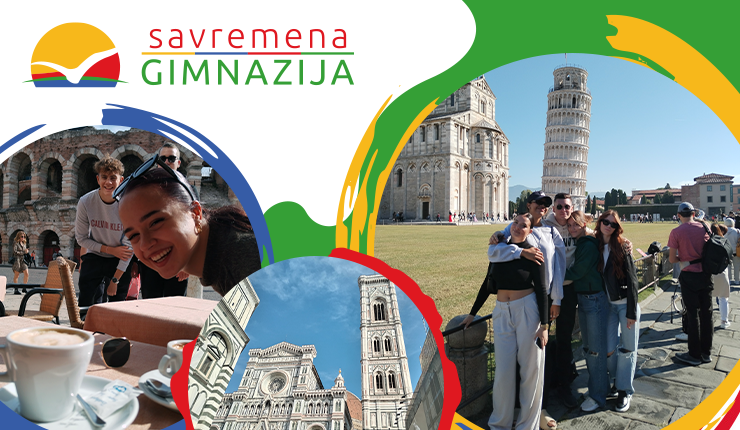
On 11 October, graduates of Savremena Gimnazija set off on their last trip together with their class teachers. Starting from Belgrade, they passed through Croatia and Slovenia and finally arrived in Italy.
A stay in Verona – an unforgettable and wonderful experience for graduates of Savremena
 The next day they visited Verona, a city located in the northern part of Italy, in the province of Veneto. The area of Verona was inhabited since prehistoric times. The city settlement was formed by the Romans when they occupied this area around 300 BC. At the beginning of the Middle Ages, Verona was besieged by numerous barbarian tribes, so it was eventually transformed into a northern Italian city-state. Due to the great competition with the Republic of Venice, the Venetians conquered Verona at the beginning of the fifteenth century and it remained in their hands until the fall of Venice itself in 1797. After that, Verona changed its masters several times, and in 1866 it was annexed to the newly established Kingdom of Italy. Verona experienced rapid development during the twentieth century and today it is one of the most developed cities in Italy. Among the many attractions of this city, our students saw the Verona Arena, the third largest preserved Roman amphitheatre. It was built in the 1st century, is 139 metres long and 110 metres wide, and the amphitheatre can accommodate 30,000 visitors. Gladiatorial fights were held there, and today opera and ballet performances are performed in the Arena.
The next day they visited Verona, a city located in the northern part of Italy, in the province of Veneto. The area of Verona was inhabited since prehistoric times. The city settlement was formed by the Romans when they occupied this area around 300 BC. At the beginning of the Middle Ages, Verona was besieged by numerous barbarian tribes, so it was eventually transformed into a northern Italian city-state. Due to the great competition with the Republic of Venice, the Venetians conquered Verona at the beginning of the fifteenth century and it remained in their hands until the fall of Venice itself in 1797. After that, Verona changed its masters several times, and in 1866 it was annexed to the newly established Kingdom of Italy. Verona experienced rapid development during the twentieth century and today it is one of the most developed cities in Italy. Among the many attractions of this city, our students saw the Verona Arena, the third largest preserved Roman amphitheatre. It was built in the 1st century, is 139 metres long and 110 metres wide, and the amphitheatre can accommodate 30,000 visitors. Gladiatorial fights were held there, and today opera and ballet performances are performed in the Arena.
The cathedral was built in the 12th century and is designed in a romantic style. It has been renovated several times, but its original appearance has not changed. The interior of the cathedral is filled with various Christian symbols, such as ten figures of prophets, symbols of the evangelists and the hand of God. There are also figures of Roland and Oliver, holy warriors who protect the church. The interior itself dates from the 15th century.
Piazza Erbe – the central square of Verona (Piazza delle Erbe) represents the place where the Roman Forum (Forum Romanum) was once located. The central part of this square is dominated by the Madonna, a sculpture from the Roman period and a wonderful example of unusual architecture. There is also the Lamberti Tower (Torre dei Lamberti), the highest tower in Verona, and the beautiful Mafei Palace (Palazzo Mafei) from 1668. It was built in the Baroque style, and its top is decorated with statues of six Greek gods (Hercules, Jupiter, Venus, Mercury, Apollo and Minerva). The statue Lion of Saint Mark, the symbol of Venice, is located in front of this palace.
Juliet's house (the house of the Capulet family) dates from the 13th century and is decorated with Gothic windows. There is also a balcony where Romeo and Juliet had unforgettable conversations. The furniture in the house is from the 14th century, and there are also wooden stairs and a brick fireplace. Romeo's house (the house of the Montecchi family) dates back to the 13th century, and on its facade is an inscription with Romeo's famous words: "O Romeo, Romeo, why are you Romeo?". Verona is a city of culture, so since 1997, its monuments have been on the UNESCO World Heritage List under the name of the Old Town of Verona. The stay in Verona was an unforgettable and wonderful experience for our students.
The enchanting sight of the Leaning Tower of Pisa
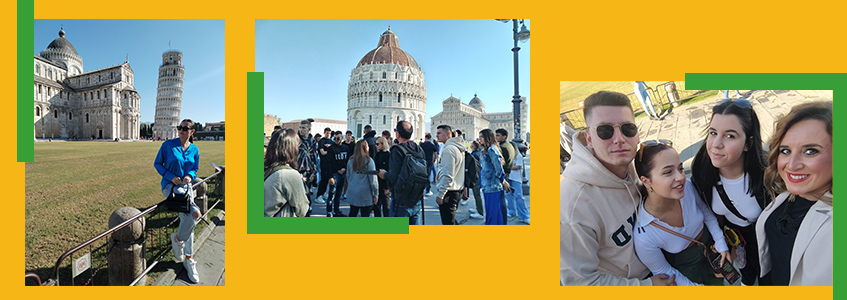 Fourth-graders of Savremena also visited Pisa – once a powerful naval power, whose fleet was the strongest fleet in the Mediterranean Sea for almost 150 years (until the end of the 13th century). Pisa is a city in the region of Tuscany. Archaeological remains, dating back to the 5th century BC, indicate that Pisa was an important trading centre. It experienced the peak of its power in the 9th century when it became one of the most important ports in Italy. It was very powerful and rich from the 11th to the 15th century, until it fell into the hands of the Republic f Florence.
Fourth-graders of Savremena also visited Pisa – once a powerful naval power, whose fleet was the strongest fleet in the Mediterranean Sea for almost 150 years (until the end of the 13th century). Pisa is a city in the region of Tuscany. Archaeological remains, dating back to the 5th century BC, indicate that Pisa was an important trading centre. It experienced the peak of its power in the 9th century when it became one of the most important ports in Italy. It was very powerful and rich from the 11th to the 15th century, until it fell into the hands of the Republic f Florence.
Thanks to tourism, the city recovered during the previous decades, so it is now a magnet for many tourists, and it is best known for the iconic Leaning Tower. The Leaning Tower of Pisa (Torre Pendente di Pisa) is the city's biggest tourist attraction. Already leaning when it was completed in 1372, the 56-metre-long white marble cylinder is actually the bell tower of the Romanesque, striped cathedral that rises alongside it in the Square of Miracles (Piazza dei Miracoli). This imposing cathedral of clear structure and elegant appearance with the subtle decoration of facades, windows and balconies and bronze panels on the doors is a truly enchanting sight, which has to be seen.
There is also a baptistery on the square. This circular building, which represents a combination of Romanesque and Gothic elements, was built according to the project of Diotisalvi. The interior of the baptistery is the result of two centuries of intensive construction. The interior of this building is characterised by exceptional acoustics, and the octagonal room, built by Guido Bigarelli in 1246, as well as the pulpit from 1260, the work of Niccolò Pisano, is particularly interesting. Today, Pisa is also famous for being the home to the three most important universities in Italy.
Florence and its many cultural and historical attractions
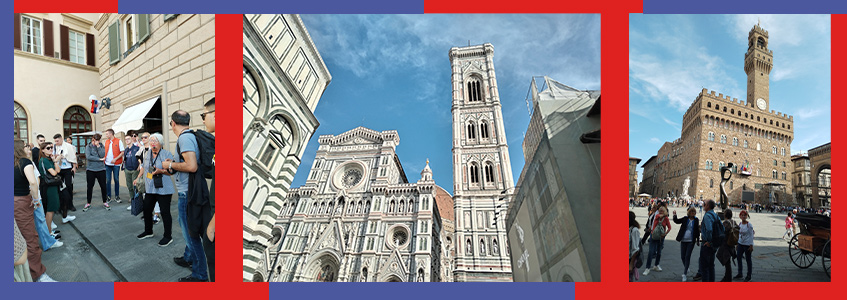 The graduates of Savremena Gimnazija also visited Florence, the capital of the province of Tuscany, located in the central part of Italy. Due to its long tradition, part of Florence is on the UNESCO World Heritage List. The Romans founded the settlement in the 1st century BC and named it Florentia. The city was besieged by numerous barbarian nations for centuries, and after fighting for independence, Florence became one of the most powerful cities in Italy. It was here that the famous Renaissance art style developed, in which the world's greatest artists, who lived and worked in this city, created their works of art: Donatello, Botticelli, Michelangelo, Machiavelli, Leonardo da Vinci and many others. In the 18th century, Florence fell under the Habsburgs and remained in their hands, except during the Napoleonic wars, until 1859, when it was annexed to the Kingdom of Italy. During the 20th century, Florence experienced modern development, which is why today it is one of the most developed cities in Italy.
The graduates of Savremena Gimnazija also visited Florence, the capital of the province of Tuscany, located in the central part of Italy. Due to its long tradition, part of Florence is on the UNESCO World Heritage List. The Romans founded the settlement in the 1st century BC and named it Florentia. The city was besieged by numerous barbarian nations for centuries, and after fighting for independence, Florence became one of the most powerful cities in Italy. It was here that the famous Renaissance art style developed, in which the world's greatest artists, who lived and worked in this city, created their works of art: Donatello, Botticelli, Michelangelo, Machiavelli, Leonardo da Vinci and many others. In the 18th century, Florence fell under the Habsburgs and remained in their hands, except during the Napoleonic wars, until 1859, when it was annexed to the Kingdom of Italy. During the 20th century, Florence experienced modern development, which is why today it is one of the most developed cities in Italy.
Florence is a very attractive tourist destination, with numerous cultural-historical and other attractions. The Florence Cathedral (Santa Maria del Fiore) is one of the most famous churches in the world. Its construction began at the end of the 13th century, and it was completed after 170 years. Ponte Vecchio is a bridge built in the 14th century and is the only one that was not destroyed in the bombing during the Second World War. It is made of three main arches, the largest of which is 30 metres long, and the other two are 27 metres long. Today it is full of goldsmiths, and once butchers had their shops here.
Piti Palace (Palazzo Pitti) is a Renaissance palace located on the south side of the Arno River. It was built in the 15th century and was the home of the banker Pythia. Some hundred years later, it was bought by the Medici family and has served as their residence ever since.
Today, Signoria Square (Piazza della Signoria) is one of the two most famous Florentine squares, and it used to be the centre of the political power of the Republic of Florence. Here are numerous city attractions, such as palaces, galleries, monuments, Neptune's Fountain and more. The square got its name from the Signoria Palace (Palazzo della Signoria), i.e. Palazzo Vecchio, the old palace of the Medici family. Santa Croce (Basilica di Santa Croce) is a church where the tombs of Italian great artists, such as Dante, Galileo and Michelangelo are. There are also several important works of art, icons, frescoes and crosses.
The Uffizi Gallery is one of the oldest and most famous museums in the world. The construction of this building began in 1560 and was completed after twenty-one years. It was primarily used as a building that housed the offices of the judges, and later exhibited the artistic legacy of the Medici family. It was opened as a museum in 1765, and the gallery contains priceless works by famous masters, such as Botticelli, Leonardo, Michelangelo and Raphael. Florence is a city with a long tradition and culture. Visitors often stand in lines for hours to admire some of the most famous works of art in this city. A visit to Florence was guaranteed to be an unforgettable experience for our graduate students. The memories from this beautiful place will surely never be forgotten.
A medieval fairy-tale place: the hill town of San Gimignano
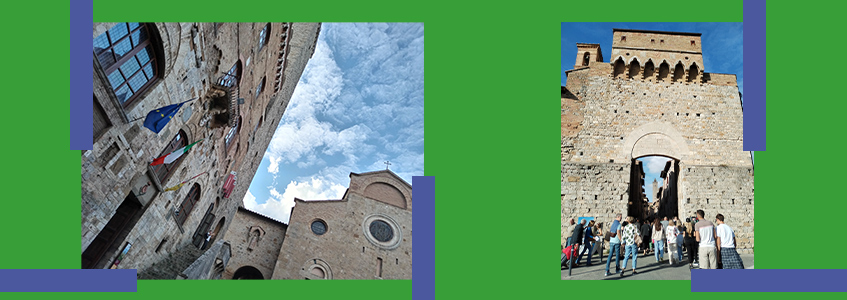 The graduates of Savremena Gimnazija also visited San Gimignano, an Italian hill town in Tuscany, located southwest of Florence. It was once surrounded by 72 beautiful towers, of which only 14 remain, towering over the Elsa River valley, making the city look like a medieval fairy-tale place. It is surrounded by walls from the 13th century, with the old town centres on Cisterna Square (Piazza Della Cisterna), which is triangular in shape and lined with medieval houses. The second square – Duomo Square (Piazza del Duomo) – was the centre of the religious and political life of medieval San Gimignano. In this square is the Duomo church (Collegiata di Santa Maria Assunta) – from the 12th century – with frescoes painted by Ghirlandaio in the Chapel of Santa Fina, in front of which is the beautiful Vecchio del Podesta Palace (Palazzo Vecchio del Podestà). Within this square is the Ronjosa Tower (Torre Rognosa), which is 51 metres high and has 17 floors.
The graduates of Savremena Gimnazija also visited San Gimignano, an Italian hill town in Tuscany, located southwest of Florence. It was once surrounded by 72 beautiful towers, of which only 14 remain, towering over the Elsa River valley, making the city look like a medieval fairy-tale place. It is surrounded by walls from the 13th century, with the old town centres on Cisterna Square (Piazza Della Cisterna), which is triangular in shape and lined with medieval houses. The second square – Duomo Square (Piazza del Duomo) – was the centre of the religious and political life of medieval San Gimignano. In this square is the Duomo church (Collegiata di Santa Maria Assunta) – from the 12th century – with frescoes painted by Ghirlandaio in the Chapel of Santa Fina, in front of which is the beautiful Vecchio del Podesta Palace (Palazzo Vecchio del Podestà). Within this square is the Ronjosa Tower (Torre Rognosa), which is 51 metres high and has 17 floors.
Siena – historical centre with medieval architecture in full glory
 The graduates, alongside their class teachers, continued their journey to Siena, one of the most impressive cities in Italy, a city that has a historic centre with medieval architecture in full glory. In the Middle Ages, Siena was an extremely wealthy city-state until neighbouring Florence took over that role. Today it is one of the most visited cities in Italy, and the main attraction is the city centre, which has been transformed into a pedestrian zone and is located within the city walls.
The graduates, alongside their class teachers, continued their journey to Siena, one of the most impressive cities in Italy, a city that has a historic centre with medieval architecture in full glory. In the Middle Ages, Siena was an extremely wealthy city-state until neighbouring Florence took over that role. Today it is one of the most visited cities in Italy, and the main attraction is the city centre, which has been transformed into a pedestrian zone and is located within the city walls.
The Campo square, which has been working since its foundation (Piazza del Campo), designed in the shape of a shell, is the most famous square in the city. The city's cathedral, the Duomo, is built in the Romanesque style and houses some of the most famous works of art of medieval Italy. Construction began in the 12th century, and the main facade was completed only in 1380. This cathedral is also known for having a base facing north-south, which is unusual for Christian churches.
There is also the Baptistery of St. John (Battistero di San Giovanni), which was designed between 1316 and 1325 by the sculptor and architect Camaino de Crescentino. The Public Palace (Palazzo Comunale) is a building that has housed the town hall for 800 years, and there are also famous frescoes by the artist Ambrogio Lorenzetti. From this square, you can enter the Torre di Mangia, a tower that offers a view of the entire city and its surroundings. The Salimbeni Palace, built in 1472, is the medieval headquarters of the oldest bank in the world, which has been operating since its foundation.
Graduates of Savremena in wonderful Venice
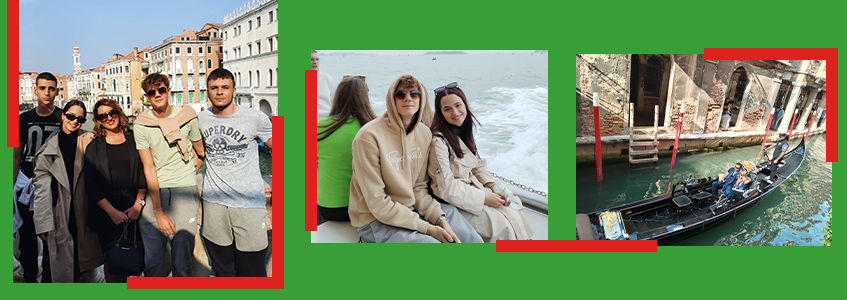 After boarding the ship, our students headed for the unique and wonderful Venice, a city located at the confluence of the Brenta River with the Adriatic Sea, on 118 small islands, separated by about 180 canals, and connected by about 400 smaller and larger bridges. In Venetian palaces, churches, museums and galleries, there are priceless artistic treasures, created mainly in the period from the 5th to the end of the 18th century, when Venice was the capital of the Venetian Republic, which played a very important role in the history of Europe. This was followed by a tour of St. Mark's Square (Piazza San Marco) and St. Mark’s Basilica (Basilica di San Marco), the Doge's Palace (Palazzo Ducale) and the Bridge of Sighs (Ponte dei Sospiri) – the centre of Venice, which is part of the world cultural heritage, i.e. under the protection of UNESCO.
After boarding the ship, our students headed for the unique and wonderful Venice, a city located at the confluence of the Brenta River with the Adriatic Sea, on 118 small islands, separated by about 180 canals, and connected by about 400 smaller and larger bridges. In Venetian palaces, churches, museums and galleries, there are priceless artistic treasures, created mainly in the period from the 5th to the end of the 18th century, when Venice was the capital of the Venetian Republic, which played a very important role in the history of Europe. This was followed by a tour of St. Mark's Square (Piazza San Marco) and St. Mark’s Basilica (Basilica di San Marco), the Doge's Palace (Palazzo Ducale) and the Bridge of Sighs (Ponte dei Sospiri) – the centre of Venice, which is part of the world cultural heritage, i.e. under the protection of UNESCO.
The cosmopolitan spirit of Trieste
 On the last day of their study trip, the students visited Trieste, an important city and port in Italy on the Adriatic coast. According to Nikola Dučić, the city got its name from the Slavic word "trstika", i.e. reed, which is abundant here on the seashore. The area of today's Trieste was inhabited as far back as prehistoric times, more precisely 3,000 years BC. when the Karni tribe settled here. This area was conquered by the Romans in 177 BC. and then the present name of the city – Tergeste – was mentioned for the first time.
On the last day of their study trip, the students visited Trieste, an important city and port in Italy on the Adriatic coast. According to Nikola Dučić, the city got its name from the Slavic word "trstika", i.e. reed, which is abundant here on the seashore. The area of today's Trieste was inhabited as far back as prehistoric times, more precisely 3,000 years BC. when the Karni tribe settled here. This area was conquered by the Romans in 177 BC. and then the present name of the city – Tergeste – was mentioned for the first time.
Later, the city belonged to Byzantium, then to the Frankish Kingdom, and then to its successors. In 1382, Trieste came under Habsburg rule. From the 18th century and the development of trade, it became increasingly important as the most important port of the imperial city of Vienna and gradually lost its autonomy. At the same time, the construction of a larger city port begins, and at the same time, the construction of a modern city. The immigration of people from all parts of the Habsburg Monarchy begins and the city acquires a cosmopolitan character. Among them are Serbs, mostly from Herzegovina and Boka Kotorska. Although small in number, the Serbian community was influential in Trieste, with many wealthy individuals and families whose palaces and endowments can still be found throughout the city.
Trieste has preserved the old city centre from the 18th and 19th centuries, which, due to its "northern" appearance and regular street network, is completely different from other centres of Italian cities, because the influence of "Habsburg architecture" was significant. Today, Trieste is more reminiscent of Vienna than of nearby Venice or Verona. The city has a large number of squares with many churches, palaces, buildings and monuments. Due to their compactness, Trieste buildings, even those that are several decades old, have a considerable number of floors. The Serbian Orthodox Church of St. Spiridon on the main city square, Ponte Rosso, is particularly important for Serbian culture. This church is one of the largest Serbian churches and bears witness to the former wealth of the small Serbian community in Trieste.
Tired, but with a smile on their faces, our graduates returned to Belgrade
The graduates of Savremena and their class teachers arrived in Belgrade almost in the morning hours. Tired, but with smiles on their faces, they were greeted by their parents, to whom they excitedly retold their impressions from the trip.





